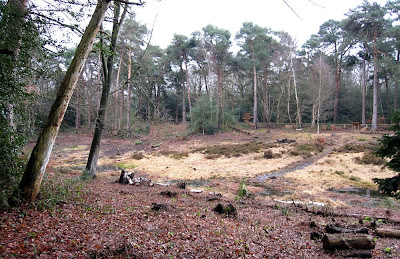 |
| Keston Bog in winter |
The village was very popular a century ago, and could have thousands of visitors in one day, coming in to Hayes station and then on foot over Hayes common or by bus. There were many tearooms, now all gone, though now there is a delicatessen (reopening soon after a fire) and one, soon to be two, new restaurants.
The common was once mostly privately owned but has expanded by purchase and gift. It has wet and dry meadows and also a bog, shown in the top photo. This bog is the only site in London where Sphagnum moss grows. It was much visited by Darwin, who was particularly interested in its insect-eating sundews, which no longer grow there. The trees that have been shading out the bog have been cut back recently, which might help it to recover.
 |
| Botany Bay in Keston |
Above the common is an area of Blackheath gravel, once much quarried by the locals, and three ponds, great for wildlife and the haunt of Daubenton's bats. I have also seen terrapins in the lower pond; these intrusive predators appeared in many water habitats after the craze for Mutant Ninja Turtles in the 1980s, when they were bought as pets and later released into the wild.
The second photo is a small group of houses called Botany Bay, where the workers for Keston Mill used to live. The mill is an icon of Keston and has a Wikipedia entry which you can find from the link. Botany Bay is down the hillside and completely out of sight of the village and the road, so is little known even to the locals.
No comments:
Post a Comment